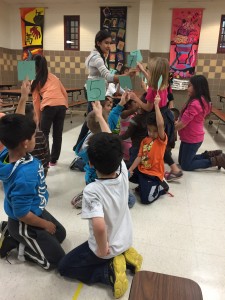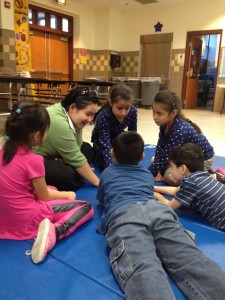Toyota Family Learning: Lincoln Public Schools’ World Games
 Every Monday since October, mothers participating in Lincoln Public Schools’ Toyota Family Learning have hosted a World Games after-school club for students in grades K-2.
Every Monday since October, mothers participating in Lincoln Public Schools’ Toyota Family Learning have hosted a World Games after-school club for students in grades K-2.
Working and learning alongside their own children, these parents of multicultural backgrounds translated the rules from their native languages to English, and then presented their traditional childhood games to students and school staff members from Everett Elementary School in Lincoln, Nebraska.
Principal Michelle Suarez said parents involved in the after-school club have grown in confidence in a special way.
“When families contribute and their own children see them as the leaders they are, we all win,” she said. “School staff, our students and the community see our parents as the leaders they are. The students in the club enjoy an engaging experience each Monday.”
 Many students attended the World Games club and enjoyed learning how to play childhood games popular in countries like Mexico, Guatemala, and Burma (via the Thailand Refugee Camps). The children of those who presented were also proud to see their parents take a leadership position.
Many students attended the World Games club and enjoyed learning how to play childhood games popular in countries like Mexico, Guatemala, and Burma (via the Thailand Refugee Camps). The children of those who presented were also proud to see their parents take a leadership position.
“Kids were excited to see their moms teaching their games to other children,” said Minerva Martinez from Mexico.
“My daughter — so excited. She told her father, ‘Father, mom is a leader in this school and she taught the kids.’ My husband said, ‘You are so excited for your mom!'” shared Hser Ku Moo from Burma.
Some of the children’s favorite games included the Number Game and Pop the Balloon Game from Mexico, and the Jump the Rope game from Burma.
JUMP THE ROPE
Materials Needed:
- 6 players in two groups of 3
- “Rope” (about 6 feet long and made of rubber bands looped together)
- Gym mats on which to play
Steps in the game:
- Have 2 players hold the rope (the 35 child waits/watches) and the other 3 will jump the rope.
- To begin, the rope is held tight at the foot level and players hop on one foot to get over the rope.
- The rope is raised to knee level and players hop over it.
- The rope is raised to hip level and players step or climb over the rope.
- The rope is progressively raised to the heart level, neck level, ear level and then top of the head (if the players can get over the rope.
- After players jump and makes it over, they can help their own team members by jumping for them or helping them get over the rope. Its ok to touch the rope when you jump.
- When no one on the team can get over the rope, the teams trade places: the jumpers hold the rope and the players who held the rope now jump. The rope is lowered back down to foot level and the game begins again.
POP THE BALLOON GAME
Materials Needed:
- Two teams of at least 2 players each
- Small balloons (2 or 4 per player), blow them up
- A spool of ribbon or string, cut 1 or 2 foot long pieces for each player
- Tie 2 balloons on each piece of ribbon
Steps in the Game:
- Divide the players into 2 teams
- Tie ribbon (with 2 balloons) around one or both ankles of the players
- Tell players to try to pop the balloons on other players’ ankles while keeping their balloons safe
- Start the game
- When players have all their balloons popped, they sit down.
- The game continues until the last player still has balloons with air in them
THE NUMBER GAME
Materials Needed:
- 8 or more players, divided in 2 teams
- 2 sets of the cards with numbers written on cards and glued to popsicle sticks
- Each set of cards will have the same numbers on them (2 of each of the #1 — 5 for 4 players per team)
- Two team captains (often adults to keep the game going)
Steps in the Game:
- Divide the players into 2 teams and move apart with the captains.
- Captains give each player a number card; first they ‘hide” their cards by holding them toward their chest until the game begins.
- One number card will not be given out (extra stays with captain).
- One captains says to begin.
- The teams of players hold up their cards and quickly move to the center (between the two teams) and find the other player with the same number.
- When players with matching numbers find each other they sit down together.
- Any player without a matching partner is ‘out” and leaves the game.
- The players return to the captain for new cards. Go back to step 2.
- Play until all players are eliminated. Then begin again.